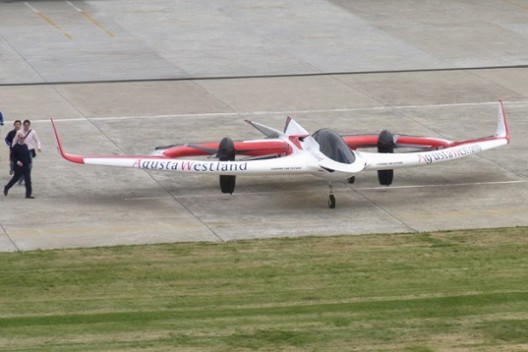AugustaWestland, after keeping the world’s first electric tilt-rotor aircraft under wraps for nearly two years, is letting the public in on its exciting new design.
According to the company, “The tilt rotor technology demonstrator is completely electric powered; designed to hover like a helicopter and convert to a fixed wing aircraft in forward flight thanks to its two integrated rotors which can be tilted through more than 90 degrees. The demonstrator performed its first unmanned tethered flight in June 2011 at AgustaWestland’s Cascina Costa facility in Italy and has since performed untethered hovering flights inside a secured area.”
Emulating Bell Boeing V-22 Osprey flight characteristics, Project Zero affirms that AugustaWestland thinks tilt-rotor technology is “the best layout for the future of fast vertical lift aircraft.”
VerticalMag.com explains the aerodynamics and controls of the new vehicle: “During cruise, the wings will provide most of the lift, with the blended fuselage and shroud also making a contribution. ‘Project Zero’ has been designed with detachable outer wings for missions that will be performed primarily in helicopter mode. Elevons provide pitch and roll control in forward flight while the V-tail provides longitudinal stability. The aircraft has very low noise and thermal signature in flight and does not require oxygen, thereby permitting it to fly at altitude or in heavily polluted conditions, such as volcanic eruptions.”
“We strongly believe in the tilt rotor concept as the future of high speed rotorcraft flight,” Daniele Romiti, CEO of AgustaWestland asserts. “It offers much greater speed and range than compound helicopter technology.” The electrical drive system is also lighter and less complex than the transmission system required by conventional rotorcraft.
Unlike the Osprey, and the Bell Augusta 609 civilian tilt-rotor aircraft, which have tilting rotors at the end of short wings, Project Zero integrates its electrically-driven rotors within its wings. These rotors can be rotated more than 90 degrees, positioned horizontally during takeoffs and landings and vertically for rapid forward flight. Adding to its versatility, the craft’s wing tips can be detached for missions when Project Zero will be used as a helicopter.
AgustaWestland hasn’t provided any specifications for the craft, and is somewhat ambiguous on whether the airplane has flown with a pilot on board.
Electrically powered now, it could house a hybrid Diesel-electric power system. In a ground-bound form of regeneration, the craft could be pointed into the breeze, with its windmilling blades able to recharge its batteries.
This newly-announced design is similar to the Verticopter chronicled in this blog. We await further information on the unspecified, but “high-power” batteries used in Project Zero, as well as more details on its motor/controller systems.


Comments 1
“the craft could be pointed into the breeze, with its windmilling blades able to recharge its batteries.” Wouldn’t the blades hit the ground?
(Editor’s Note: Anybody? AugustaWestland?)